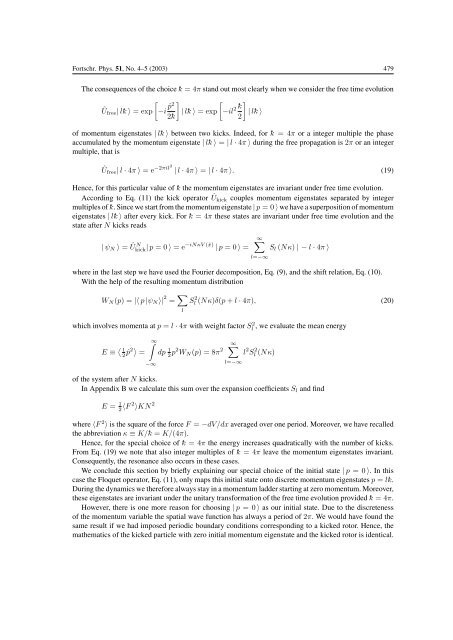Kicked rotor in Wigner phase space - The University of Texas at Austin
Kicked rotor in Wigner phase space - The University of Texas at Austin
Kicked rotor in Wigner phase space - The University of Texas at Austin
Create successful ePaper yourself
Turn your PDF publications into a flip-book with our unique Google optimized e-Paper software.
Fortschr. Phys. 51, No. 4–5 (2003) 479<br />
<strong>The</strong> consequences <strong>of</strong> the choice k - =4π stand out most clearly when we consider the free time evolution<br />
Ûfree| lk- <br />
〉 = exp −i ˆp2<br />
2k- <br />
| lk- <br />
2 k-<br />
〉 = exp −il | lk<br />
2<br />
- 〉<br />
<strong>of</strong> momentum eigenst<strong>at</strong>es | lk - 〉 between two kicks. Indeed, for k - =4π or a <strong>in</strong>teger multiplethe<strong>phase</strong><br />
accumul<strong>at</strong>ed by the momentum eigenst<strong>at</strong>e | lk - 〉 = | l · 4π 〉 dur<strong>in</strong>g thefreepropag<strong>at</strong>ion is 2π or an <strong>in</strong>teger<br />
multiple, th<strong>at</strong> is<br />
Ûfree| l · 4π 〉 =e −2πil2<br />
| l · 4π 〉 = | l · 4π 〉. (19)<br />
Hence, for this particular value <strong>of</strong> k - the momentum eigenst<strong>at</strong>es are <strong>in</strong>variant under free time evolution.<br />
Accord<strong>in</strong>g to Eq. (11) thekick oper<strong>at</strong>or Ûkick couples momentum eigenst<strong>at</strong>es separ<strong>at</strong>ed by <strong>in</strong>teger<br />
multiples <strong>of</strong> k - . S<strong>in</strong>cewestart from themomentum eigenst<strong>at</strong>e| p =0〉 wehavea superposition <strong>of</strong> momentum<br />
eigenst<strong>at</strong>es | lk - 〉 after every kick. For k - =4π these st<strong>at</strong>es are <strong>in</strong>variant under free time evolution and the<br />
st<strong>at</strong>eafter N kicks reads<br />
| ψN 〉 = Û N kick| p =0〉 =e −iNκV (ˆx) | p =0〉 =<br />
∞<br />
l=−∞<br />
Sl (Nκ) |−l · 4π 〉<br />
where<strong>in</strong> thelast step wehaveused theFourier decomposition, Eq. (9), and theshift rel<strong>at</strong>ion, Eq. (10).<br />
With the help <strong>of</strong> the result<strong>in</strong>g momentum distribution<br />
WN(p) =|〈 p |ψN〉| 2 = <br />
S 2 l (Nκ)δ(p + l · 4π), (20)<br />
l<br />
which <strong>in</strong>volves momenta <strong>at</strong> p = l · 4π with weight factor S2 l , weevalu<strong>at</strong>ethemean energy<br />
E ≡ 1<br />
2 ˆp2 =<br />
∞<br />
−∞<br />
dp 1<br />
2 p2 WN(p) =8π 2<br />
∞<br />
l=−∞<br />
l 2 S 2 l (Nκ)<br />
<strong>of</strong> the system after N kicks.<br />
In Appendix B we calcul<strong>at</strong>e this sum over the expansion coefficients Sl and f<strong>in</strong>d<br />
E = 1<br />
2 〈F 2 〉KN 2<br />
where 〈F 2 〉 is thesquare<strong>of</strong> theforceF = −dV/dx averaged over one period. Moreover, we have recalled<br />
theabbrevi<strong>at</strong>ion κ ≡ K/k - = K/(4π).<br />
Hence, for the special choice <strong>of</strong> k - =4π the energy <strong>in</strong>creases quadr<strong>at</strong>ically with the number <strong>of</strong> kicks.<br />
From Eq. (19) wenoteth<strong>at</strong> also <strong>in</strong>teger multiples <strong>of</strong> k - =4π leave the momentum eigenst<strong>at</strong>es <strong>in</strong>variant.<br />
Consequently, the resonance also occurs <strong>in</strong> these cases.<br />
Weconcludethis section by briefly expla<strong>in</strong><strong>in</strong>g our special choice<strong>of</strong> the<strong>in</strong>itial st<strong>at</strong>e| p =0〉. In this<br />
case the Floquet oper<strong>at</strong>or, Eq. (11), only maps this <strong>in</strong>itial st<strong>at</strong>e onto discrete momentum eigenst<strong>at</strong>es p = lk - .<br />
Dur<strong>in</strong>g the dynamics we therefore always stay <strong>in</strong> a momentum ladder start<strong>in</strong>g <strong>at</strong> zero momentum. Moreover,<br />
these eigenst<strong>at</strong>es are <strong>in</strong>variant under the unitary transform<strong>at</strong>ion <strong>of</strong> the free time evolution provided k - =4π.<br />
However, thereis onemorereason for choos<strong>in</strong>g | p =0〉 as our <strong>in</strong>itial st<strong>at</strong>e. Due to the discreteness<br />
<strong>of</strong> themomentum variablethesp<strong>at</strong>ial wavefunction has always a period <strong>of</strong> 2π. Wewould havefound the<br />
same result if we had imposed periodic boundary conditions correspond<strong>in</strong>g to a kicked <strong>rotor</strong>. Hence, the<br />
m<strong>at</strong>hem<strong>at</strong>ics <strong>of</strong> the kicked particle with zero <strong>in</strong>itial momentum eigenst<strong>at</strong>e and the kicked <strong>rotor</strong> is identical.
















